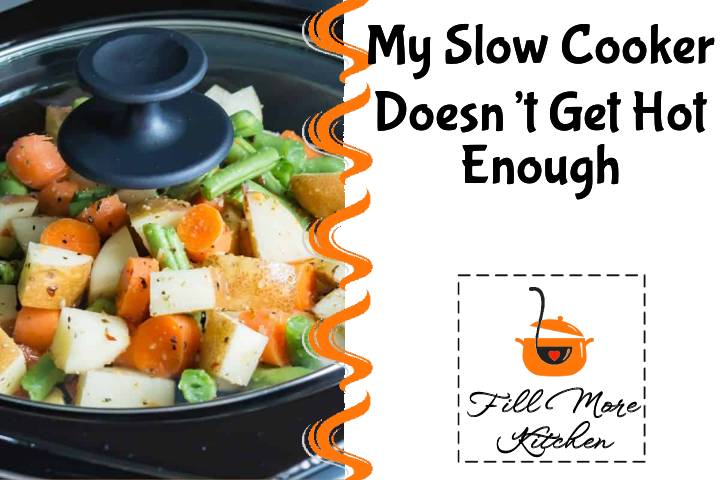Slow cookers are ideal for cooking food at a gentle temperature that is neither too high nor too low. If the temperature is too high, the nutrients in the food may be lost, while if it’s too low, the cooking time may be extended and the food may not reach a safe temperature for consumption.
Although being too hot is not a significant problem, having a slow cooker that is not sufficiently hot can be quite worrisome.
If your slow cooker is not getting hot enough, there could be several factors to consider. One of these factors may be the amount of food you are cooking, as having too much or too little food can impact the temperature rise.
Occasionally, an excessive amount of food or a high fill level in the slow cooker can result in inadequate or slow heating. If you have confirmed that the slow cooker is connected to a functional outlet and ruled out the fill level as the cause of low temperature, it is likely that there is an underlying issue with the electrical components.
What Affects The Temperature Of A Slow Cooker?
Considering that a slow cooker, similar to other cooking devices, consists of various electrical components, it’s not unexpected that there are numerous factors involved in controlling its temperature, particularly the appropriate temperature.
Due to the numerous components and parts, a single mistake could result in the entire slow cooker malfunctioning.
Factors that can impact the temperature of a slow cooker include both external and internal variables.
- Exceeding the recommended amount of food in the slow cooker, which is typically ¾ of its capacity, can result in insufficient heating.
- The effectiveness of the lid seal can impact the temperature of the slow cooker, as frequent lifting of the lid releases hot air pressure and inadequate sealing allows heat to escape.
- The placement of the heating elements in the slow cooker can affect how quickly they heat up, with those located on the bottom taking longer than those situated around the walls that enclose the contents.
- The slow cooker’s model determines the type of temperature and heating controls it has, with some models featuring continuous heating and others equipped with built-in temperature control.
- The heating rate of a slow cooker varies depending on the type of food or ingredients used, such as whole foods, fatty foods, or liquids, as they have different liquid or fat content.
Components Responsible For Your Slow Cookerâs Temperature

Aside from the aforementioned factors, the electrical components play a crucial role in achieving the ideal temperature in a slow cooker. If insufficient filling or other trivial reasons are not to blame for the inadequate heating of your slow cooker, it is highly probable that a defective or malfunctioning electrical component is the culprit.
Below are the primary electrical parts that make up a slow cooker:
- Thermal fuse or just a fuse is accountable for avoiding your slow cooker from getting excessively hot and overheating, as it shuts off the heat when the slow cooker reaches a specific high temperature to prevent any fire hazard. However, if the fuse is defective or burnt out, which is quite frequent, it may turn off the heat even before the slow cooker gets hot enough.
- Temperature switch is responsible for regulating the cooking time and temperature in a slow cooker, but if it’s faulty, you may not be able to set the desired temperature or it may not work at all; while a broken control board can also affect the switch, replacing the switch or switches could solve the problem.
- The control/circuit board acts as the central point for all electrical parts that enable the slow cooker to function properly, and is similar to the small green box with wire pathways found in many electronics. If this component is damaged, regardless of how high you set the switch, the slow cooker will not reach the desired temperature.
- Heating Element is the crucial component responsible for heating your food in the slow cooker. It serves as the source and creator of heat, making it essential to keep your slow cooker hot. Without it, your slow cooker won’t be able to produce any heat.
- Probe is a sensor that detects the temperature of both the slow cooker and the food inside it, and if it gets damaged or broken, it will prevent the slow cooker from heating up properly by delaying the detection of food temperature.
How To Check The Temperature Of Your Slow Cooker
It can be difficult to determine the reason for your slow cooker not reaching adequate temperatures without obvious signs. However, you can assess the issue by performing a few straightforward steps to measure its temperature.
Verifying the functionality of your slow cooker is not only crucial to ensure its proper heating, but also imperative to comply with the current food safety standards.
If you want to check the temperature of your slow cooker:
- Put water in your slow cooker until it reaches halfway to the top, regardless of its temperature.
- To address the issue of a slow cooker that doesn’t get hot enough, set the temperature or heating switch to its minimum level and cover the appliance with its lid for a duration of 8 hours.
- After 8 hours, uncover the slow cooker and quickly measure the water temperature using a cooking thermometer. The water should be around 185 degrees Fahrenheit initially, and a slightly higher temperature indicates faster heating. But if the temperature is lower than 185 degrees, it suggests an underlying issue.
Consider replacing your appliance if the temperature is below 185 degrees. Ideally, a slow cooker should reach 200 degrees on low and 300 degrees on high.
If you’re having trouble with My Slow Cooker not getting hot enough, it’s important to test it out. Here are some tips on how to check your slow cooker.
In order to determine if My Slow Cooker is functioning properly, you should conduct a few tests. Here are some suggestions for testing your slow cooker and ensuring it is heating up adequately.
If the temperature of your slow cooker is below 185 degrees F after conducting this test, then your suspicion that it wasn’t heating up enough was correct, and it would be best to replace it.
If you cannot replace the slow cooker, consult the owner’s manual to find repair options.
Moreover, you may investigate whether an electrical malfunction is responsible for the insufficient temperature and reach out to the manufacturer of your slow cooker for additional assistance and alternatives. For safety purposes, it is advisable not to utilize your slow cooker until then.
Consuming food that is not fully cooked or raw can pose a risk to your health and should always be avoided.
You can also check this video about “My Slow Cooker Doesn’t Get Hot Enough”
Check out our top 10 reviews!
Related posts
https://fillmorekitchen.com/why-wont-my-toaster-oven-turn-on-fix/
https://fillmorekitchen.com/why-is-there-white-stuff-in-my-cup-of-coffee-can-i-drink-it/
https://fillmorekitchen.com/can-you-use-an-oven-with-a-broken-heating-element/
https://fillmorekitchen.com/do-gas-appliances-work-when-the-power-is-out/
https://fillmorekitchen.com/how-many-potato-chip-bags-to-buy-for-any-group-size/



